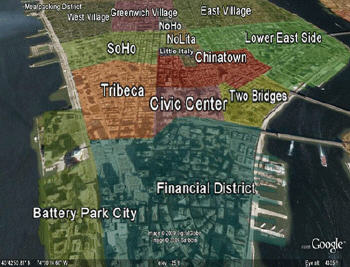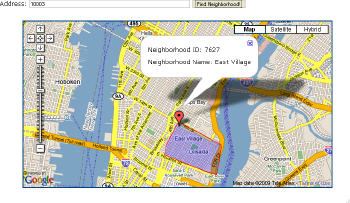The API is what some might call a mix of a data service (subscribers have access to the data itself) and an analytical service (subscribers can perform attribute and spatial queries). The developer can, for example, ask for a list of neighborhoods closest to a location point, the neighborhood in which a point or address falls, a list of the neighborhoods within a city, ZIP Code or state, or the XML encoded latitude/longitude points that make up a neighborhood boundary surrounding a given address or location point. What is not delivered, Clement is quick to point out, is a mapping engine. The developer will typically use a client side rendering tool like Google Maps or Virtual Earth.
The development of the whole offering - from writing the API, to finding an external hosting service and bandwidth, to determining administration and pricing - took just a few months. While the API is rolling out in 2009, the idea and planning for it has gone on for some time. Customers, reports Clement, have been asking for something like this for many years. Part of the reason is the nature of Maponics customers. Few are "GIS" companies; instead they are involved in some other business (real estate, local search, wireless, social media) that needs to use the localized data, but not host it, update it or chunk it up into tiles.
 |
Clement recounts the history of Maponics (and many other data providers) data delivery: "tapes, CDs, DVDs, FTP..." On the receiving end were IT people loading data, building applications, and then updating data once per quarter. With the new API, Maponics data will still be updated quarterly; there'll just be no loading or updating! For now, Maponics has no plans to change its update schedule from quarterly, but will listen with care to what API clients request.
Pricing, at least at the outset, is not per transaction, but rather "all you can eat" based on which datasets and how much of the API are needed. Again, that strategy for the rollout is geared toward existing large Maponics customers. In the future, Clement notes, the company may look into transaction-based pricing for smaller users. How does Maponics expect to fair with the new offering? Clement is coy: "I expect there will be sufficient demand for the API services to be a good part of our 2009/2010 revenue."
Clement is not ready to write an obituary for physical media delivery for another few years. "Some clients have existing infrastructures [hardware and applications] that require them to stick to the traditional model of receiving and loading the data each quarter. Moving them to the new API, if and when they are ready, may take a few years." He suggests it may be two to three years until the overall market starts to expect all data providers to deliver via API.
With two big players, TomTom/Tele Atlas and Nokia/NAVTEQ, dominating the worldwide basemap market, there's not much room for new players unless they are in niche markets. In what market is Maponics? Clement offers a GIS-friendly reply: "We see ourselves as the polygon company." His logic: It's easy to capture points; anyone can do that. And, Tele Atlas and NAVTEQ have a huge lead on the infrastructure required to create and maintain the key linear features, roads. That leaves what Clement calls the "most relevant" data, the "where am I?" data, the polygon that names a neighborhood or carrier route or other local area. Maponics can take advantage of that relevance, but also the fact that these and other polygon datasets are difficult to define. While GPSs and aerial imagery are very valuable for the collection of points of interest or street networks, those tools are not as helpful in finding neighborhood boundaries or other human social constructs. There's a whole different infrastructure and expertise required to create and update them.
Maponics claims to be the first data development company to deliver its entire neighborhood dataset via an API, including the full boundary coordinate stream. It certainly won't be the last to offer data and analytical tools that way. Clement expects to see a steady march in that direction by data companies worldwide.
